Abstract
Synthesis by the hydrothermal method has various advantages, including low reaction temperature, three-dimensional substrate availability, and automatic polarization alignment during the process. In this review, powder synthesis, the fabrication of piezoelectric thin films, and their applications are introduced. A polycrystalline lead zirconate titanate (PZT) thin film was applied to a micro ultrasonic motor, and an epitaxial lead titanate (PbTiO3) thin film was estimated as a ferroelectric data storage medium. Ferroelectric and piezoelectric properties were successfully obtained for epitaxial PbTiO3 films. As lead-free piezoelectric powders, KNbO3 and NaNbO3 powders were synthesized by the hydrothermal method and sintered together to form (K,Na)NbO3 ceramics, from which reasonable piezoelectric performance was achieved.
1. Introduction
Piezoelectric materials are widely utilized as electromechanical energy converters for actuators, sensors, and transformers [1,2]. Compared to magnetic devices, piezoelectric devices have a simple structure and high energy density, which contributes to the distinguished performance observed for miniaturized systems. Therefore, suitable deposition processes are necessary to fabricate piezoelectric films in such micro actuators and sensors.
Among the various deposition processes, the hydrothermal method has a unique advantage of low reaction temperature, less than 200 °C [3,4,5,6,7,8,9,10,11,12] in the case of lead zirconate titanate (PZT) or lead titanate (PbTiO3) films, which is below the Curie temperature. This low reaction temperature results in excellent crystal quality by reducing the residual strain. Furthermore, direct synthesis as an ionic reaction in solution enables high-quality thin film deposition without impurities. Other advantages of PZT or PbTiO3 films synthesized via the hydrothermal method are large thickness, the availability of a three dimensional structure substrate and self-alignment polarization.
In addition to PZT thin films, environmental friendly piezoelectric materials, such as lead-free piezoelectric powders synthesized by the hydrothermal method, have been investigated [13,14,15]. One of the promising lead-free piezoelectric materials is potassium niobate-based ceramics, such as (K,Na)NbO3. Synthesis of such materials by the conventional solid state process has some serious problems, due to the instability and deliquescence of potassium carbonate, which is generally used as a potassium source. To overcome this problem, powders produced by the hydrothermal method were examined, and good piezoelectric performance of the sintered ceramics was successfully achieved.
In this review paper, the hydrothermal synthesis method is explained for ferroelectric materials, and a micro ultrasonic motor [16,17] is introduced as an example of a polycrystalline PZT thin film application. A hydrothermally deposited epitaxial PbTiO3 thin film [7] is also demonstrated as a memory medium for a ferroelectric hard-disk device. In addition, the hydrothermal fabrication process for lead-free piezoelectric powders, KNbO3 and NaNbO3, is described, and the piezoelectric performance of a sintered solid-phase (K,Na)NbO3 of these powders is presented [13,14,15].
2. Hydrothermal Synthesis of PZT or PbTiO3 Films
The hydrothermal method is a unique method to obtain piezoelectric materials by utilizing chemical reaction in solution at a reaction temperature of less than 200 °C (Figure 1). In case of PZT thin film deposition, the ion sources, Pb(NO3)2, ZrOCl2·8H2O, and TiO2 or TiCl4, are placed in a high pressure container with KOH solution. A substrate is then placed into the solution, and the high pressure container is placed in an oven for a predetermined time, for example, 24 h. Thicker films can be realized by repeating the reaction process. Detailed reaction conditions are given in [4,5,6,7,8].
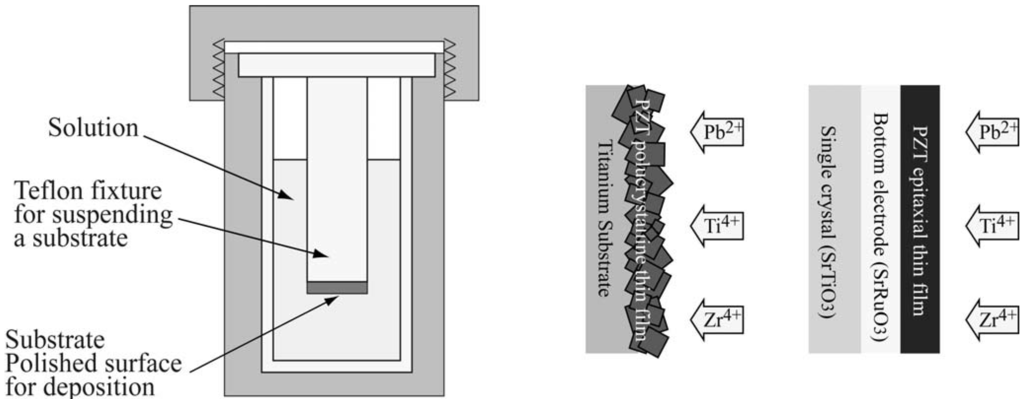
Figure 1.
Hydrothermal method to deposit polycrystalline and epitaxial PZT.
Polycrystalline PZT has been obtained on a titanium metal substrate [4,5]. With respect to ease of fabrication, a metal substrate has advantages over a single crystal substrate. However, high-quality epitaxial PZT or PbTiO3 thin films can be deposited on a single crystal substrate such as SrTiO3 [6,7,8,9,10]. SrTiO3 has superior lattice matching to PZT or PbTiO3 and has high resistance against strongly alkali conditions. By improving the reaction conditions and adapting the SrRuO3 bottom electrode on SrTiO3, the ferroelectric and the piezoelectric properties were successfully measured [8]. These results confirmed that high-quality piezoelectric film can be deposited by the hydrothermal method.
2.1. Micro Ultrasonic Motor Using Polycrystalline PZT Thin Film
As an example of the application of polycrystalline PZT thin films, a micro ultrasonic motor was fabricated and is shown in Figure 2 [16,17]. The stator transducer has an outer diameter of 1.4 mm, an inner diameter of 1.2 mm, and is 5 mm long. The base metal of the stator transducer was titanium, and a PZT thin film was deposited on the sidewall, as shown in Figure 3, using an improved hydrothermal method. The thickness of the PZT thin film was increased to 12 μm by repeating the hydrothermal deposition reaction four times. The film thickness saturates during the hydrothermal reaction, and by repeating the reaction times, it could be increased. The poling direction was automatically aligned to the thickness direction. Four gold electrodes were deposited onto the PZT thin film by evaporation of gold with a metal mask.
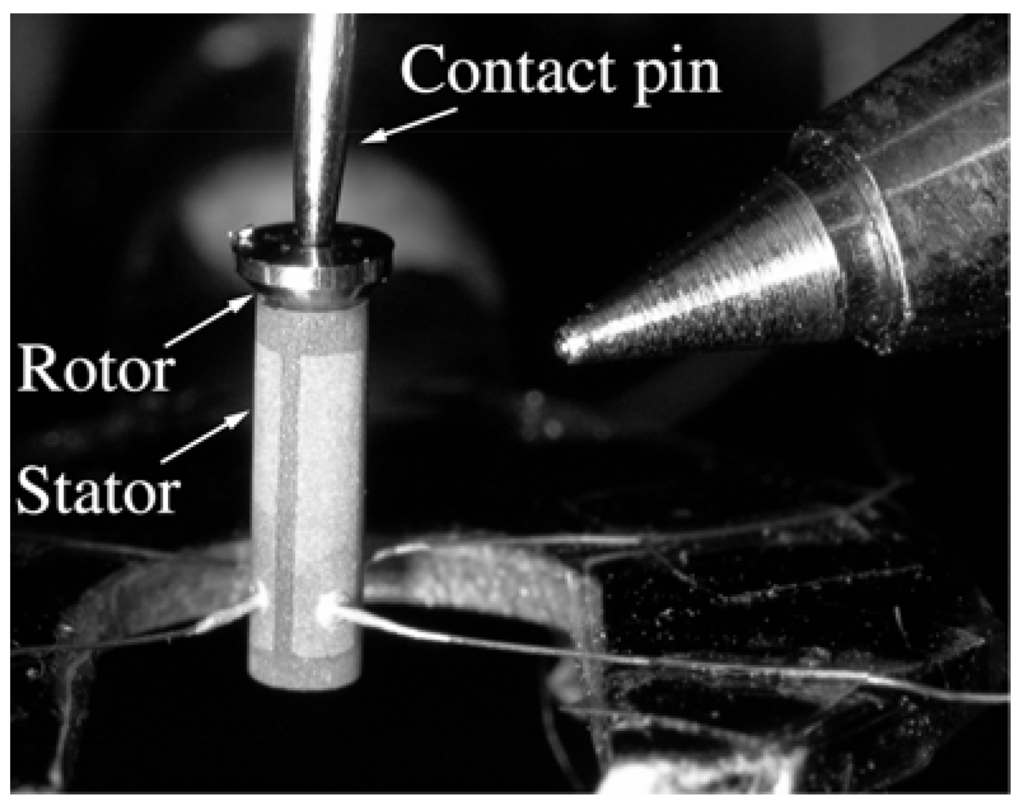
Figure 2.
Cylindrical-shaped micro ultrasonic motor using polycrystalline PZT film [17].
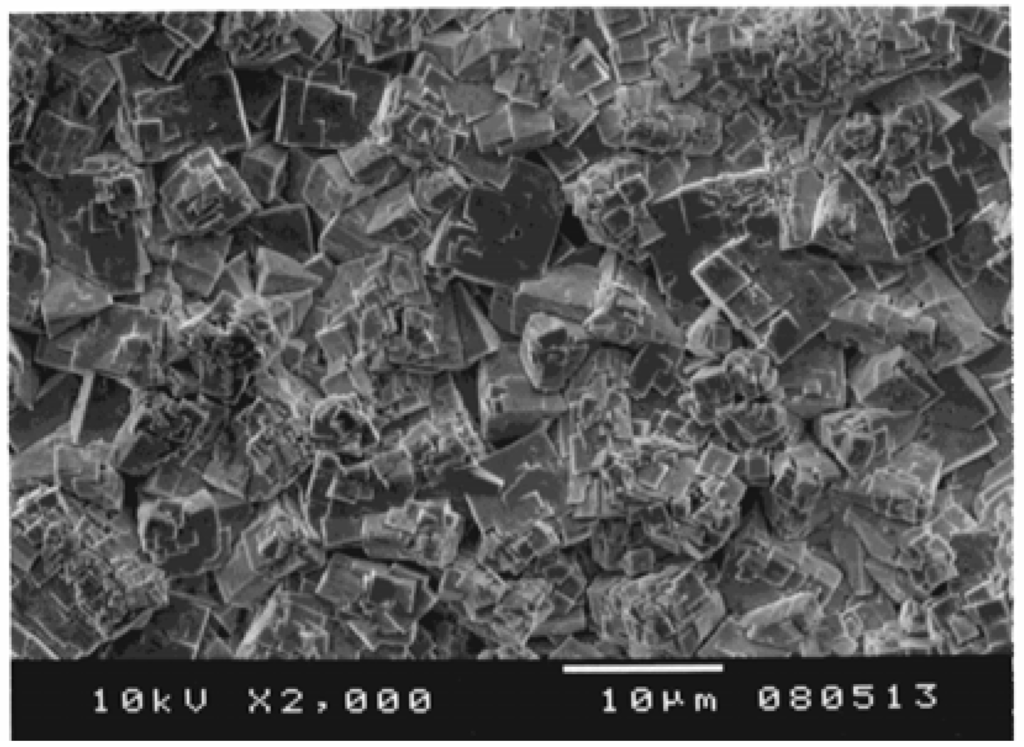
Figure 3.
Polycrystalline PZT thin film deposited by the hydrothermal method.
The ultrasonic motor is a mode-rotation type, which utilizes the first bending vibration mode. With four driving electrical sources connected to each electrode, the bending vibration is degenerated, with phase differences of 90° to each other. The traveling wave is propagated at both end surfaces of the stator, and the rotor loaded on the transducer rotates by frictional force. The driving direction is reversible by changing the electrical phase shift from 90 to −90°.
The maximum torque was 0.67 μNm with 5.3 mN pre-load and 20 V input voltage. The driving frequency was 227 kHz, which corresponded to the resonant frequency of the transducer. Under the same conditions, the convergent revolution speed was 680 rpm. From the vibration performance obtained with three different dimension stators, the piezoelectric coefficient e31 was estimated to be −0.57 C/m2. Smaller ultrasonic motor performance was estimated from this value. The output torque of 27 nNm for a 100 μm diameter motor is sufficient as a micro actuator when compared with an electrostatic micro motor or a previous disk type micro ultrasonic motor, of which the output torque was in the order of pNm. Thus, the output torque indicates that the ultrasonic motor is a promising actuator for micromechanical systems. A tactile sensor [18] and miniature earphone [19] have also been reported as applications using polycrystalline PZT films synthesized by the hydrothermal method.
2.2. Piezoelectric Properties of Epitaxial PbTiO3 Thin Film
PbTiO3 is a fundamental ferroelectric material and is important as a component of solid solutions such as PZT and lead magnesium niobate-lead titanate (PMN-PT). However, it has been difficult to realize PbTiO3 with sufficient resistivity, and there have been few experimental results regarding the ferroelectric and piezoelectric properties of PbTiO3.
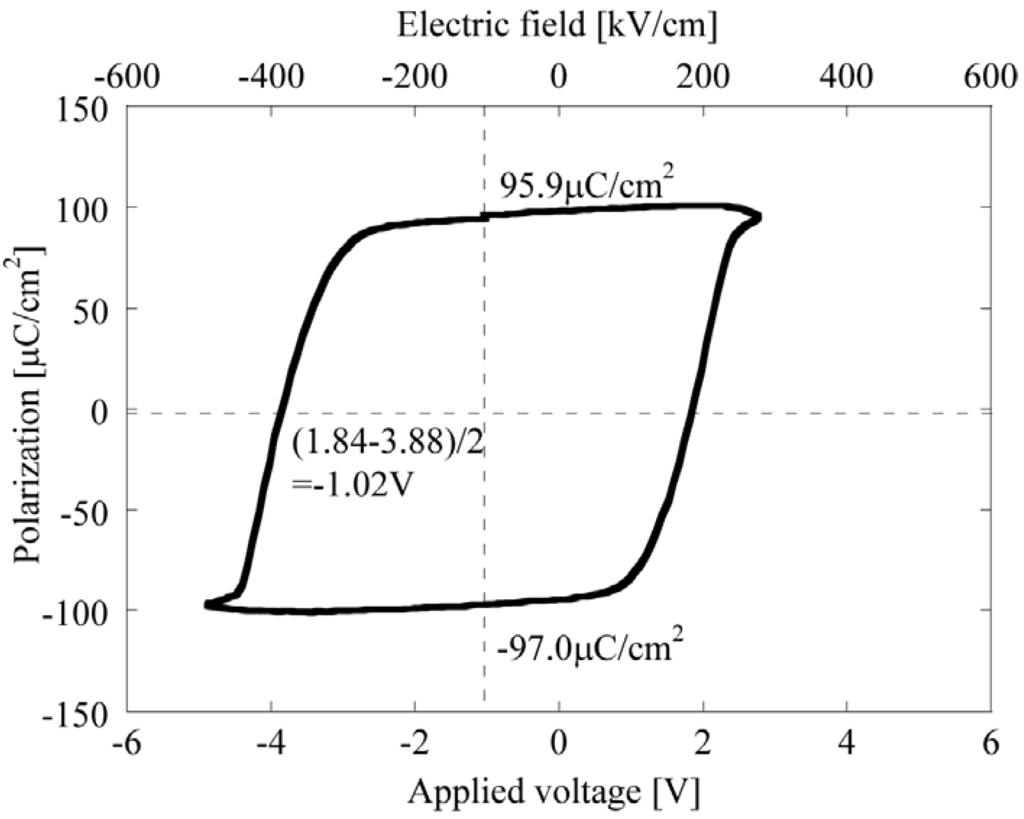
Figure 4.
Ferroelectric hysteresis curve of the PbTiO3 thin film [7].
A high-quality crystal PbTiO3 epitaxial thin film was successfully obtained by the hydrothermal method [7,8]. After a 24 h reaction, the thickness was 100 nm. This film indicated 96.5 μC/cm2 remnant polarization in DE hysteresis measurements as shown in Figure 4. The deposited film was perfectly epitaxial with a polarization direction from the top surface to the underlying SrRuO3 electrode without poling treatment. A thinner 50 nm epitaxial thin film was examined as a ferroelectric medium for an ultra-high-density storage system. This system utilized a scanning nonlinear dielectric microscope (SNDM) invented by Cho et al. [20,21]. A nanodot pattern was obtained in this system, as shown in Figure 5, which suggests that hydrothermal PbTiO3 thin film can be utilized as data media for ferroelectric data storage systems [21].
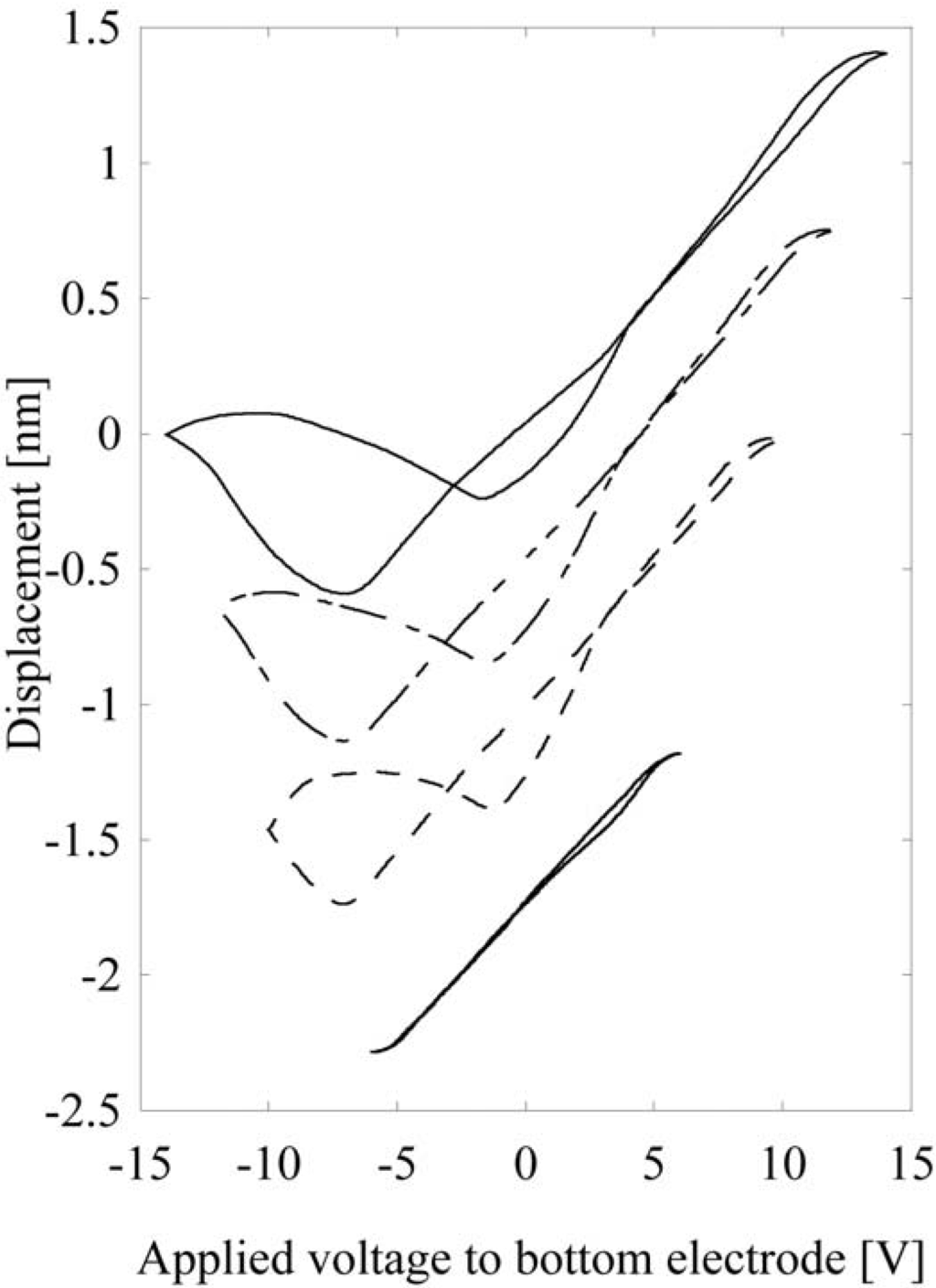
Figure 5.
Relationship between piezoelectric displacement and input voltage [8].
Besides application in ultra-high density data storage media, PbTiO3 films have significant potential for use as piezoelectric actuators and sensors, particularly as high frequency ultrasonic transducers. By changing the reaction parameters, 430 nm thick PbTiO3 epitaxial film was deposited and its piezoelectric properties were examined. The domain structure was composed of dominant +c-domain and a small amount of a-domain. The strain has splendid linearity, as shown in Figure 6, and the d33eff coefficient was found to be 97 pC/N, which is larger than the predicted value [22]. The large piezoelectric performance and linearity are especially suitable for ultrasonic transducer applications.
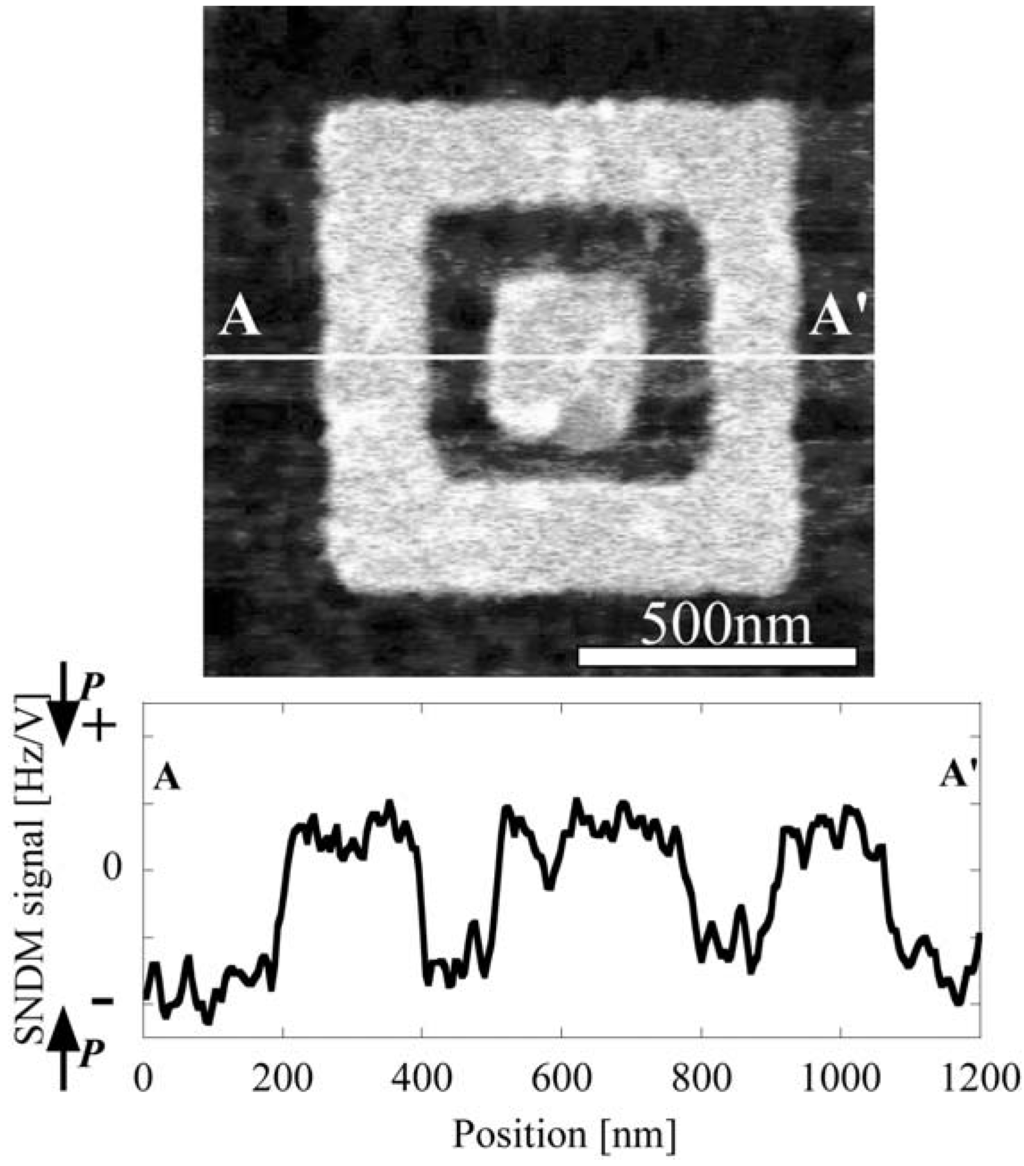
Figure 6.
Domain patterning in the PbTiO3 epitaxial thin film using a scanning nonlinear dielectric microscope (SNDM) [8].
3. Lead-free Piezoelectric Ceramics from Hydrothermal Powders
Lead-free piezoelectric ceramics have been widely studied as replacements for PZT ceramics. Alkaline niobate-based piezoelectric ceramics have good piezoelectric properties and high Curie temperatures. Among these, (K,Na)NbO3 is considered as a promising candidate for lead-free piezoelectric ceramics. Usually, the solid solution method is used to obtain source powders; however, potassium carbonate (K2CO3) as a potassium source is unstable and quite difficult to weigh due to its deliquescence. Another problem is that the potassium is easily evaporated during the sintering process.
In contrast, the hydrothermal method is proposed to obtain source powders for these ceramics, and it has been verified that this method enables the production of high-quality powders [13,14]. Crystallization from the solution was achieved with the hydrothermal method, so that pure crystal powder could be obtained without difficulty. In addition, the potassium to niobium ratio was automatically controlled to be one. Therefore, the simple process and low reaction temperature (around 200 °C) provide this method with certain advantages over other conventional methods.
The KNbO3 and NaNbO3 powders were sintered to form the (K,Na)NbO3 solid solution, as shown in Figure 7. An SEM micrograph of the sintered (K,Na)NbO3 ceramics is shown in Figure 8. The piezoelectric performance of (K,Na)NbO3 was estimated from admittance measurements, one example of which is shown in Figure 9. Properties obtained for the sintered (K,Na)NbO3 ceramic were the electromechanical coupling factors kp (0.32) and k33 (0.48), the mechanical quality factor Qm 71 (radial mode), 118 ((33)mode), and the piezoelectric constant d33 (107 pC/N) [14].
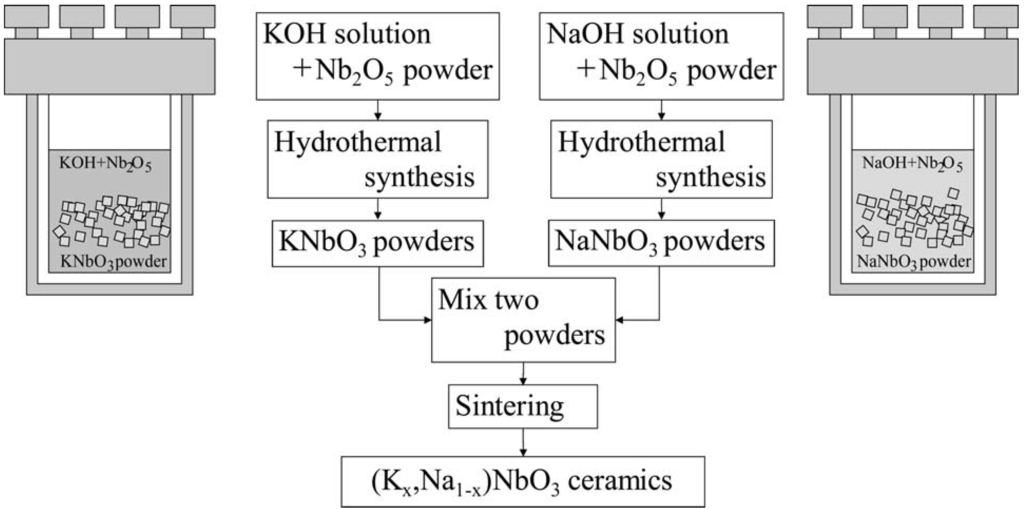
Figure 7.
Hydrothermal method to obtain lead-free piezoelectric powders and the sintering process.

Figure 8.
SEM photograph of (K,Na)NbO3 ceramic sintered from powders synthesized by the hydrothermal method [14].
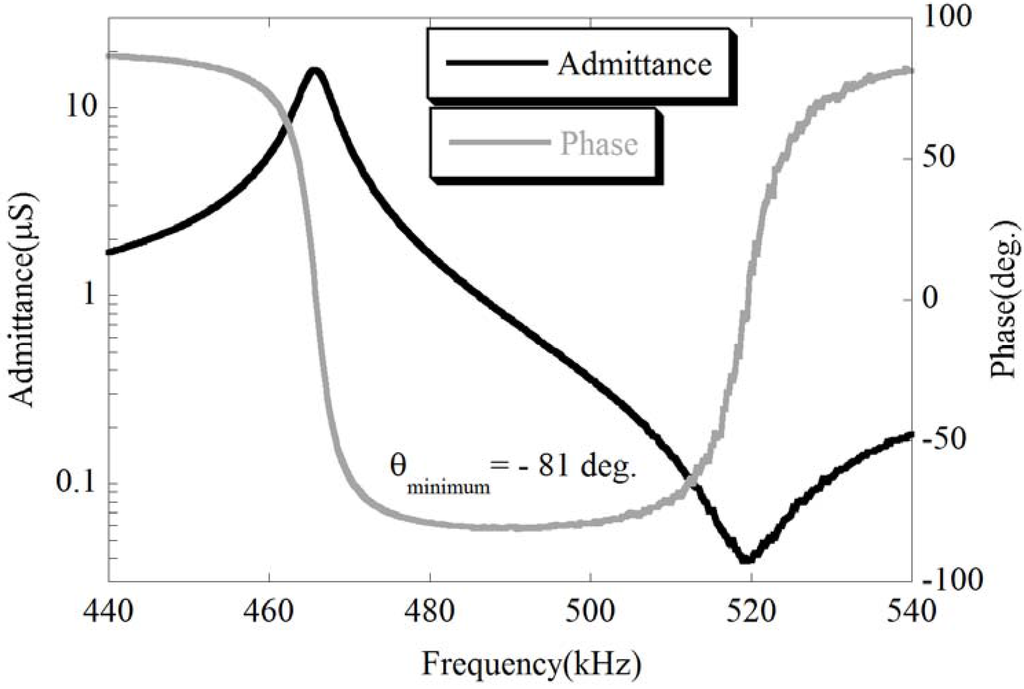
Figure 9.
Admittance and phase curve of the (K,Na)NbO3 ceramic [14].
4. Summary
The hydrothermal method was introduced as a simple, low-temperature process for the deposition of PZT polycrystalline films and epitaxial PbTiO3 film. A micro ultrasonic motor was fabricated and successfully operated as an application of polycrystalline PZT thin film. d33 measurements were carried out for the PbTiO3 epitaxial film, and the results indicated the potential of the hydrothermal method for the fabrication of ultra-high-quality films. KNbO3 and NaNbO3 powders were synthesized as source powders for the synthesis of lead-free piezoelectric ceramics, and they were sintered together to form a (K,Na)NbO3 solid solution, the piezoelectric properties of which indicated that the hydrothermal method has significant advantages for the fabrication of lead-free piezoelectric materials.
Acknowledgements
The author acknowledges support for the PZT deposition studies from M.K. Kurosawa and H. Funakubo of the Tokyo Inst. of Tech., T. Higuchi of Tokyo Univ., N. Setter of EPFL, and Y. Cho of Tohoku Univ. I would also like to thank T. Hemsel at Paderborn Univ. for cooperation in these studies of lead-free piezoelectric ceramics.
References and Notes
- Morita, T. Miniature piezoelectric motor. Sens. Actuators A 2003, 103, 291–300. [Google Scholar] [CrossRef]
- Muralt, P. Ferroelectric thin films for micro-sensors and actuators: A review. J. Micromech. Microeng. 2000, 10, 136–146. [Google Scholar] [CrossRef]
- Lange, F.F. Chemical solution routes to single-crystal thin films. Science 1996, 273, 903–909. [Google Scholar] [CrossRef] [PubMed]
- Morita, T.; Kanda, T.; Yamagata, Y.; Kurosawa, M.K. Single process to deposit lead zirconate titanate (PZT) thin film by hydrothermal method. Jpn. J. Appl. Phys. 1997, 36, 2298–2299. [Google Scholar] [CrossRef]
- Shimomura, K.; Tsurumi, T.; Ohba, Y.; Daimon, M. Preparation of lead zirconate titanate thin film by hydrothermal method. Jpn. J. Appl. Phys. 1991, 30, 2174–2177. [Google Scholar] [CrossRef]
- Morita, T.; Wagatsuma, Y.; Cho, Y.; Morioka, H.; Funakubo, H.; Setter, N. Ferroelectric properties of an epitaxial lead zirconate titanate thin film deposited by a hydrothermal method below the Curie temperature. Appl. Phys. Lett. 2004, 84, 5094–5096. [Google Scholar] [CrossRef]
- Morita, T.; Cho, Y.A. hydrothermally deposited epitaxial lead titanate thin film on strontium ruthenium oxide bottom electrode. Appl. Phys. Lett. 2004, 58, 2331–2333. [Google Scholar] [CrossRef]
- Morita, T.; Cho, Y. Piezoelectric property of an epitaxial lead titanate thin film deposited by the hydrothermal method. Appl. Phys. Lett. 2006, 88, 112908. [Google Scholar] [CrossRef]
- Chien, A.T.; Speck, J.S.; Lange, F.F. Hydrothermal synthesis of heteroepitaxial Pb(ZrxTi1-x)O3 thin films at 90-150 degrees C. J. Mater. Res. 1997, 12, 1176–1178. [Google Scholar] [CrossRef]
- Chien, A.T.; Xu, X.; Kim, J.H.; Sachleben, J.; Speck, J.S.; Lange, F.F. Electrical characterization of BaTiO3 heteroepitaxial thin films by hydrothermal synthesis. J. Mater. Res. 1999, 14, 3330–3339. [Google Scholar] [CrossRef]
- Kajiyoshi, K.; Sakabe, Y.; Yoshimura, M. Electrical properties of BaTiO3 thin film grown by the hydrothermal-electrochemical method. Jpn. J. Appl. Phys. 1997, 36, 1209–1215. [Google Scholar] [CrossRef]
- Kadota, Y.; Ishikawa, M.; Hosaka, H.; Morita, T. Ultrasonically assisted hydrothermal synthesis of polycrystalline PZT thin film on titanium substrate. IEEE Trans. Ultrason. Ferroelectr. Freq. Control 2009, 56, 9–13. [Google Scholar] [CrossRef] [PubMed]
- Ishikawa, M.; Takiguchi, N.; Hosaka, H.; Morita, T. Non-doped potassium niobate ceramics using hydrothermal method with optimum temperature condition. Jpn. J. Appl. Phys. 2008, 47, 3824–3828. [Google Scholar] [CrossRef]
- Maeda, T.; Takiguchi, N.; Ishikawa, M.; Hemsel, T.; Morita, T. (K,Na)NbO3 lead-free piezoelectric ceramics synthesized from hydrothermal powders. Mater. Lett. 2010, 64, 125–128. [Google Scholar] [CrossRef]
- Ishikawa, M.; Kadota, Y.; Takiguchi, N.; Hosaka, H.; Morita, T. Synthesis of nondoped potassium niobate ceramics using ultrasonic assisted hydrothermal method. Jpn. J. Appl. Phys. 2008, 47, 7673–7677. [Google Scholar] [CrossRef]
- Morita, T.; Kurosawa, M.K.; Higuchi, T. Cylindrical micro ultrasonic motor using PZT thin film deposited by single process hydrothermal method (diameter 2.4 mm, L10 mm stator transducer). IEEE Trans. Ultrason. Ferroelectr. Freq. Control 1998, 45, 1178–1187. [Google Scholar] [CrossRef]
- Morita, T.; Kurosawa, M.K.; Higuchi, T. A cylindrical shaped micro ultrasonic motor utilizing PZT thin film (diameter 1.4 mm and L5.0 mm stator transducer). Sens. Actuators A 2000, 83, 225–230. [Google Scholar] [CrossRef]
- Kanda, T.; Morita, T.; Kurosawa, M.K.; Higuchi, T. A flat type touch probe sensor using PZT thin film vibrator. Sens. Actuators A 2000, 83, 67–75. [Google Scholar] [CrossRef]
- Yasui, H.; Kurosawa, M.K.; Higuchi, T. Hydrothermally deposited PZT film and its application to bending vibration devices. Sens. Actuators A 2002, 96, 28–33. [Google Scholar] [CrossRef]
- Cho, Y.; Kazuta, S.; Matsuura, K. Scanning nonlinear dielectric microscopy with nanometer resolution. Appl. Phys. Lett. 1999, 75, 2833–2835. [Google Scholar] [CrossRef]
- Cho, Y.; Fujimoto, K.; Hiranaga, Y.; Wagatsuma, Y.; Onoe, A.; Terabe, K.; Kitamura, K. Tbit/inch2 ferroelectric data storage based on scanning nonlinear dielectric microscopy. Appl. Phys. Lett. 2002, 81, 4401–4403. [Google Scholar] [CrossRef]
- Haun, M.J.; Furman, E.; Jang, S.J.; Cross, L.E. Thermodynamics theory of the lead zirconate-titanate solid-solution system, 5 theoretical calculations. Ferroelectrics 1989, 99, 63–86. [Google Scholar]
© 2010 by the authors; licensee MDPI, Basel, Switzerland. This article is an open access article distributed under the terms and conditions of the Creative Commons Attribution license (http://creativecommons.org/licenses/by/3.0/).